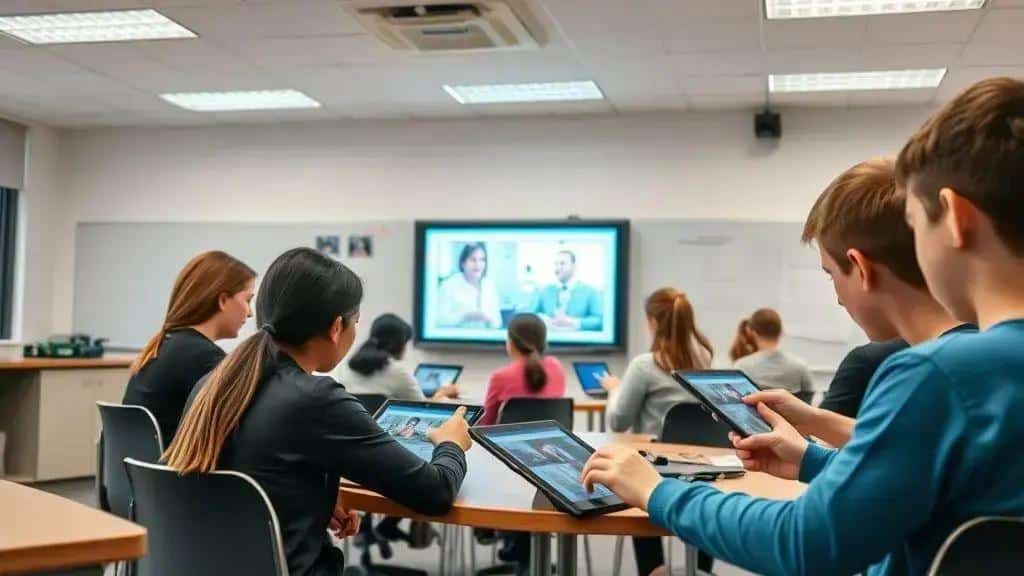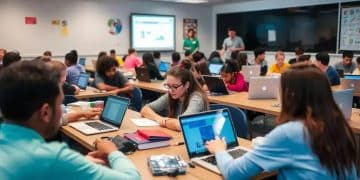Digital education resources for teachers that inspire learning

Digital education resources for teachers enhance engagement and learning by providing personalized tools, fostering collaboration, and utilizing technology like AI and VR to create dynamic classroom experiences.
Digital education resources for teachers are reshaping the learning landscape. Have you ever wondered how these tools can make a difference in your classroom? Let’s dive into the various resources that can elevate your teaching experience.
Understanding the importance of digital education resources
In today’s fast-paced world, understanding the importance of digital education resources is crucial for teachers. These tools not only enhance learning but also engage students actively. Let’s explore how these resources can transform education.
Why Digital Resources Matter
Digital education resources provide teachers with various materials to support different learning styles. They allow for personalized learning experiences that cater to each student’s needs. Moreover, these resources can make lessons more interactive, fostering student involvement.
Main Benefits of Digital Resources
- Enhanced Engagement: Interactive tools capture students’ interest more effectively than traditional methods.
- Accessibility: Digital resources can be accessed anywhere, supporting learning beyond the classroom.
- Diverse Learning Styles: Multimedia materials cater to visual, auditory, and kinesthetic learners.
- Up-to-Date Information: Online resources are regularly updated, ensuring students receive the latest knowledge.
As educators embrace technology, they can create a learning environment that is not only more engaging but also more effective. For instance, using educational videos or interactive software helps break down complex topics. This approach encourages students to explore subjects in depth and at their own pace.
Furthermore, digital tools enable collaboration among students. They can work together on projects using apps that facilitate sharing and feedback. This not only builds teamwork skills but also prepares them for real-world scenarios where collaboration is key.
In summary, recognizing the importance of digital education resources allows teachers to foster a more dynamic educational landscape. By integrating various technologies, educators can make learning more inclusive, attractive, and effective.
Best platforms for teachers to access digital materials
Finding the right platform is essential for teachers looking to access digital materials. With the right resources, educators can improve their lessons and better engage students. Here are some popular platforms that stand out in the world of digital education.
Top Platforms for Digital Materials
There are numerous options available today, each catering to different needs. Some platforms focus on lesson planning, while others provide resources or connection with peers. Whether you want interactive content or full lesson plans, here are some trusted platforms:
- Teachers Pay Teachers: A marketplace where educators can buy and sell original teaching resources.
- Google Classroom: A popular tool for organizing assignments and accessing learning materials easily.
- Khan Academy: Offers free online courses, lessons, and practice in a variety of subjects.
- Edmodo: A social networking platform designed specifically for educational purposes.
Using these platforms can streamline the process of finding resources. For example, Teachers Pay Teachers allows teachers to sell their original lessons and purchase resources made by others, expanding collaboration. This not only saves time but also fosters a sense of community among educators.
Another key benefit of using platforms like Khan Academy is the availability of a wide range of subjects. Students can work at their own pace, enhancing their learning process. Additionally, Google Classroom helps educators manage assignments, providing seamless integration with other Google apps, which many teachers already use.
Choosing the right platform helps in accessing relevant and engaging digital resources. When teachers utilize these tools effectively, they create a more dynamic and interactive learning environment. As technology evolves, exploring and integrating new platforms can enhance the teaching experience significantly.
How to integrate digital resources in lesson plans

Integrating digital resources into lesson plans can revolutionize the teaching process. By blending traditional methods with technology, teachers can create more engaging and interactive learning experiences. Here are some effective strategies to achieve this integration.
Identifying Relevant Digital Tools
The first step is to identify tools that align with curriculum goals. Consider platforms that offer interactive content or enhance classroom activities. Some options include educational videos, online quizzes, and interactive simulations.
- Interactive Videos: Use platforms like Edpuzzle to add questions and prompts.
- Online Quizzes: Tools like Kahoot! can make learning fun and competitive.
- Simulation Software: Use PhET for science classes to explore complex topics.
- Digital Whiteboards: Integrate tools like Jamboard to collaborate in real time.
Once you have the tools, it’s crucial to plan how they fit into your lessons. Think about specific lessons or units where digital resources enhance understanding. By doing this, you will create a seamless blend of various learning modalities.
Designing Engaging Activities
After selecting resources, focus on designing activities that stimulate student interaction. For example, you can pair a video with a discussion in class. This encourages critical thinking and reinforces what they learned. Additionally, consider using group projects that require students to research online and present findings.
Teachers can also encourage independence by assigning students to find digital resources related to a topic. This not only empowers them to take charge of their learning but also develops research skills. By integrating digital resources in this way, you prepare students for a technology-driven future.
Moreover, assess the effectiveness of these resources regularly. Gathering feedback from students helps refine lesson plans and ensure that digital resources are meeting learning objectives. Keeping track of what works well and what needs adjustment creates a dynamic learning environment.
Evaluating the effectiveness of digital education tools
Evaluating the effectiveness of digital education tools is essential for teachers who want to ensure their resources are making a difference. Understanding how these tools impact student learning can guide future decisions and improvements. There are several ways to assess the effectiveness of these tools.
Key Evaluation Methods
To start, use various evaluation methods that provide a comprehensive view of how well a tool works. Consider both qualitative and quantitative data to gather valuable insights.
- Surveys and Feedback: Gather student and teacher input about their experiences using the tools.
- Performance Data: Analyze student performance before and after implementing the tools to evaluate progress.
- Engagement Metrics: Track how often students interact with the digital tools and their participation levels.
- Observations: Observe classes to see how students use the tools in real-time.
After collecting the data, analyze it to identify patterns and trends. For example, if students show improved test scores after using a specific app, that tool may be effective. In contrast, low engagement might indicate a need for change.
Adjusting Strategies Based on Findings
Once you assess the results, it’s important to adjust your teaching strategies accordingly. If a tool is not meeting expectations, consider alternatives or additional training. Providing professional development can help educators maximize the potential of digital tools.
Additionally, collaborating with colleagues can provide new ideas for using resources effectively. Sharing experiences and insights can lead to enhanced strategies and improved student outcomes. By working together, teachers can create a more enriching learning environment that benefits all students.
Regularly evaluating digital education tools ensures that teachers are using the best resources available. This ongoing process not only helps maintain high education standards but also prepares students for a technology-driven world.
Future trends in digital education for teachers
Future trends in digital education for teachers are transforming how we approach teaching and learning. As technology evolves, so do the tools and resources available to educators. Understanding these trends can help teachers stay ahead and maximize their impact.
Personalized Learning Experiences
One major trend is the push towards personalized learning. This approach tailors education to meet individual student needs. Digital platforms are using data analytics to understand how each student learns best. As a result, teachers can provide customized resources that enhance engagement and understanding.
- Adaptive Learning Technologies: Programs that adjust to students’ skill levels.
- Personalized Learning Pathways: Students follow unique paths based on their interests and abilities.
- Analytics Dashboards: Tools to track progress and tailor interventions.
- Feedback Loops: Continuous feedback to improve learning outcomes.
Additionally, technologies like artificial intelligence are becoming more prevalent in the classroom. AI can automate administrative tasks, allowing teachers to focus more on student interaction. This means teachers can spend less time on grading and paperwork, enhancing their overall effectiveness.
Collaborative Tools and Virtual Learning Environments
Another key trend is the rise of collaborative tools and virtual learning environments. These platforms enable students and teachers to connect beyond traditional classroom boundaries. Tools like collaborative documents and virtual meeting spaces support group projects and discussions.
As remote learning has grown, so has the need for effective virtual environments. Teachers can create engaging online classrooms that mirror the experience of a physical classroom. Features like breakout rooms and polls make these environments interactive and productive.
Moreover, the integration of augmented reality (AR) and virtual reality (VR) into lessons is gaining traction. These technologies create immersive experiences that deepen understanding and engagement. For example, students can take virtual field trips or visualize complex concepts in 3D.
Staying updated with these future trends in digital education will empower teachers to create effective, modern learning environments. By embracing these advancements, educators can inspire students and enhance their educational experiences.
FAQ – Frequently Asked Questions about Digital Education Resources for Teachers
What are digital education resources?
Digital education resources include online tools, platforms, and materials that enhance learning and teaching in various subject areas.
How can I effectively integrate digital tools into my lesson plans?
You can integrate digital tools by identifying relevant resources, designing engaging activities, and adjusting your strategies based on student feedback.
What benefits do personalized learning paths offer?
Personalized learning paths allow students to learn at their own pace, catering to their individual strengths and weaknesses, which enhances their overall learning experience.
Why is it important to evaluate digital education tools?
Evaluating digital education tools helps ensure they are effective in improving student learning and engagement, allowing you to make informed decisions about resource use.





